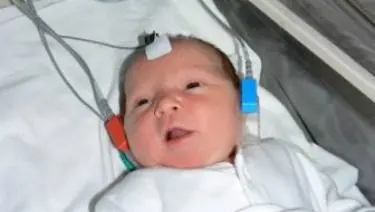Contents
Screen for hearing problems in babies
Hearing loss is very common from birth. “Profound deafness affects 1 in 1000 children at birth. And 1 in 500 children are born with sensorineural deafness, mild or profound. In two thirds of cases, this deafness has a genetic origin ”, explains Prof. Hung Thai-Van *, ENT and head of the Audiology and oto-neurological exploration department at the CHU de Lyon. The risks of these disorders if they are not taken care of early? A delay in language acquisition, behavioral, communication and school integration disorders. This is why it is essential to carry out screening as soon as possible.
Is your child affected?
Deafness screening at birth has been mandatory since the decree of April 23, 2012. This means that automated tests, currently offered in two forms, are systematically carried out in all maternity hospitals public or private, from the first days of the infant’s life. Painless, quick and easy to perform, these tests allow the assessment of the child’s responsiveness to sounds emitted at an intensity of 35 dB. Among these tests, the OEAA (automated otoacoustic emissions) test makes it possible to verify the functioning of the inner ear in just a few minutes, using a probe inserted into the ear canal. The AEP (Automated Auditory Evoked Potential), which is barely longer, makes it possible to check the functioning of the entire auditory system, and is therefore more complete. “We send, via an earpiece, a sound simulation and we record, in return, the responses of the auditory nerve”, explains Professor Hung Thai-Van. “Both of these protocols should be done in as quiet an environment as possible and preferably when the baby is sleeping. But beware, it can also happen that deafness appears until the second year of life, it is therefore necessary to remain attentive to the hearing reactions of the infant during this period, ”specifies the professor.
Here is our video article:
In video: Screening babies for hearing problems
What signs should give rise to suspicion of hearing problems?
At each stage of its development, pay attention to your child’s behavior. From 3 months to 12 months, react if you notice the disappearance of babbling or an absence of reaction to the call of his first name. From 12 to 24 months, theno words, uncontrolled vocal emissions or even exclusively gestural communication are the first indicators. From 24 to 36 months, it is a speech delay or behavioral disorders that will sound the alarm.
Screening tests adapted to his age
From the 6th month of the child, the acutropic reflex gets ready. It is a reflex of orientation towards the sound source. Its observation is a good indication of a present hearing. At 24 and 36 months, naked voice tests are offered to the child. At 4 years old, we switch to tonal and vocal audiometry, which can be combined with tympanometry. At any age, the search for otoacoustic emissions and the measurement of auditory evoked potentials will provide objective clues as to the hearing status of the child. “If the screening tests are abnormal at the maternity ward, the baby must be referred, within the next two months at most, at a medical audiology center specializing in hearing disorders in children. This will carry out a complete assessment, ”concludes the specialist.
* Prof. ORL Hung Thai-Van is head of the Audiology and Otoroneurological Exploration department at the CHU de Lyon and responsible for the Expert Center for Childhood Hearing and Balance (CEAE) in Lyon.
For more information, consult the guide to “Screening for hearing disorders in children” on the website of the Ministry of Social Affairs and Health, and the guide to “Screening for hearing disorders” on the website of the JNA association www.journee-audition.org










